Oily Wastewater Treatment by Using Fe3O4/Bentonite in Fixed-Bed Adsorption Column
Abstract
:1. Introduction
2. Materials and Methods
2.1. Chemicals
2.2. Synthesis of Fe3O4/Bent NC
2.3. Synthesis of Oil-Produced Water Emulsion
2.4. Characterization
2.5. Fixed-Bed Experiments
2.6. Fixed-Bed Data Analysis
2.7. Fixed-Bed Adsorption Model
3. Results and Discussion
3.1. Characterization of Fe3O4/Bent
3.2. Effect of Bed Height
3.3. Effect of Flow Rate
3.4. Effect of Initial Concentration
3.5. Breakthrough Curve Modeling
3.6. Adsorption Mechanism
4. Conclusions
Author Contributions
Funding
Data Availability Statement
Acknowledgments
Conflicts of Interest
References
- Chang, S.E.; Stone, J.; Demes, K.; Piscitelli, M. Consequences of oil spills: A review and framework for informing planning. Ecol. Soc. 2014, 19, 25. [Google Scholar] [CrossRef]
- Brody, T.M.; Di Bianca, P.; Krysa, J. Analysis of inland crude oil spill threats, vulnerabilities, and emergency response in the midwest United States. Risk Anal. Int. J. 2012, 32, 1741–1749. [Google Scholar] [CrossRef] [PubMed]
- Kolokoussis, P.; Karathanassi, V. Oil spill detection and mapping using sentinel 2 imagery. J. Mar. Sci. Eng. 2018, 6, 4. [Google Scholar] [CrossRef]
- Ghadhban, M.Y.; Rashid, K.T.; AbdulRazak, A.A.; Alsalhy, Q.F. Recent progress and future directions of membranes green polymers for oily wastewater treatment. Water Sci. Technol. 2023, 87, 57–82. [Google Scholar] [CrossRef]
- Fingas, M. Oil spill dispersants: A technical summary. In Oil Spill Science and Technology; Elsevier: Amsterdam, The Netherlands, 2011; pp. 435–582. [Google Scholar] [CrossRef]
- Zekri, A.Y.; Chaalal, O. Effect of temperature on biodegradation of crude oil. Energy Sources 2005, 27, 233–244. [Google Scholar] [CrossRef]
- Cisterna-Osorio, P.; Arancibia-Avila, P. Comparison of biodegradation of fats and oils by activated sludge on experimental and real scales. Water 2019, 11, 1286. [Google Scholar] [CrossRef]
- Sherhan, B.Y.; Abbas, A.D.; Alsalhy, Q.F.; Rashad, A.A.; Rashad, Z.W.; Shawkat, A.A.; Abbas, T.K.; Kareem, N.A.A. Produced water treatment using ultrafiltration and nanofiltration membranes. Al-Khwarizmi Eng. J. 2016, 12, 10–18. [Google Scholar] [CrossRef]
- Samal, K.; Geed, S.R.; Mohanty, K. Hybrid biological processes for the treatment of oily wastewater. In Advances in Oil-Water Separation; Elsevier: Amsterdam, The Netherlands, 2022; pp. 423–435. [Google Scholar] [CrossRef]
- Alsulaili, A.D.; Fahim, A.M. Oil removal from produced water by agriculture waste adsorbents. Int. J. Environ. Waste Manag. 2020, 25, 12–31. [Google Scholar] [CrossRef]
- Azeez, R.A. Removal oil from produced water by using adsorption method with adsorbent a Papyrus reeds. Eng. Technol. J. 2019, 37, 157–165. [Google Scholar] [CrossRef]
- El-Din, G.A.; Amer, A.A.; Malsh, G.; Hussein, M. Study on the use of banana peels for oil spill removal. Alexandria Eng. J. 2018, 57, 2061–2068. [Google Scholar] [CrossRef]
- Piemonte, V.; Prisciandaro, M.; Mascis, L.; Di Paola, L.; Barba, D. Reverse osmosis membranes for treatment of produced water: A process analysis. Desalination Water Treat. 2015, 55, 565–574. [Google Scholar] [CrossRef]
- Ahmad, N.A.; Goh, P.S.; Abdul Karim, Z.; Ismail, A.F. Thin film composite membrane for oily waste water treatment: Recent advances and challenges. Membranes 2018, 8, 86. [Google Scholar] [CrossRef]
- Sellami, M.; Loudiyi, K.; Bellemharbet, K.; Djabbour, N. Electro-Coagulation Treatment and De-oiling of Wastewaters Arising from Petroleum Industries. J. Pet. Environ. Biotechnol. 2016, 7, 1000290. [Google Scholar] [CrossRef]
- Xie, A.; Ladner, D.A.; Popat, S.C. Electrocoagulation-electroflotation for primary treatment of animal rendering wastewater to enable recovery of fats. Chem. Eng. J. 2022, 431, 133910. [Google Scholar] [CrossRef]
- Jiménez, S.; Andreozzi, M.; Micó, M.M.; Álvarez, M.G.; Contreras, S. Produced water treatment by advanced oxidation processes. Sci. Total Environ. 2019, 666, 12–21. [Google Scholar] [CrossRef]
- Maddah, Z.H.; Naife, T.M. Demulsification of water in Iraqi crude oil emulsion. J. Eng. 2019, 25, 37–46. [Google Scholar] [CrossRef]
- Ahmed, F.S.; Alsaffar, M.A.; AbdulRazak, A.A. One-step synthesis of magnetic fly ash composites for methylene blue removal: Batch and column study. Environ. Sci. Pollut. Res. 2022, 30, 124748–124766. [Google Scholar] [CrossRef]
- Ghasemi, A.; Ghasemi, Z. Application of SD/MNP/PEI Nanocomposite for Heavy Metals Sorption. Chem. Chem. Technol. 2023, 17, 878–886. [Google Scholar] [CrossRef]
- Khalaf, I.H.; Al-Sudani, F.T.; AbdulRazak, A.A.; Aldahri, T.; Rohani, S. Optimization of Congo red dye adsorption from wastewater by a modified commercial zeolite catalyst using response surface modeling approach. Water Sci. Technol. 2021, 83, 1369–1383. [Google Scholar] [CrossRef]
- Sarran, M.A.; AbdulRazak, A.A.; Abid, M.F.; Jawad, A.D. Oily wastewater treatment using low-cost and highly efficient natural and activated Iraqi bentonite. Desalin. Water Treat. 2024, 319, 100412. [Google Scholar] [CrossRef]
- Chatterjee, S.; Mondal, S.; De, S. Design and scaling up of fixed bed adsorption columns for lead removal by treated laterite. J. Clean. Prod. 2018, 177, 760–774. [Google Scholar] [CrossRef]
- Mahaninia, M.H.; Wilson, L.D. Phosphate uptake studies of cross-linked chitosan bead materials. J. Colloid Interface Sci. 2017, 485, 201–212. [Google Scholar] [CrossRef] [PubMed]
- Kuroki, V.; Bosco, G.E.; Fadini, P.S.; Mozeto, A.A.; Cestari, A.R.; Carvalho, W.A. Use of a La (III)-modified bentonite for effective phosphate removal from aqueous media. J. Hazard. Mater. 2014, 274, 124–131. [Google Scholar] [CrossRef] [PubMed]
- Tian, S.; Jiang, P.; Ning, P.; Su, Y. Enhanced adsorption removal of phosphate from water by mixed lanthanum/aluminum pillared montmorillonite. Chem. Eng. J. 2009, 151, 141–148. [Google Scholar] [CrossRef]
- Xu, X.; Cheng, Y.; Wu, X.; Fan, P.; Song, R. La (III)-bentonite/chitosan composite: A new type adsorbent for rapid removal of phosphate from water bodies. Appl. Clay Sci. 2020, 190, 105547. [Google Scholar] [CrossRef]
- Priya, A.K.; Yogeshwaran, V.; Rajendran, S.; Hoang, T.K.A.; Soto-Moscoso, M.; Ghfar, A.A.; Bathula, C. Investigation of mechanism of heavy metals (Cr6+, Pb2+ & Zn2+) adsorption from aqueous medium using rice husk ash: Kinetic and thermodynamic approach. Chemosphere 2022, 286, 131796. [Google Scholar] [CrossRef]
- Nguyen, V.-T.; Nguyen, T.-B.; Dat, N.D.; Huu, B.T.; Nguyen, X.-C.; Tran, T.; Bui, M.-H.; Dong, C.-D.; Bui, X.-T. Adsorption of norfloxacin from aqueous solution on biochar derived from spent coffee ground: Master variables and response surface method optimized adsorption process. Chemosphere 2022, 288, 132577. [Google Scholar] [CrossRef]
- Jeon, C. Removal of Cr (VI) from aqueous solution using amine-impregnated crab shells in the batch process. J. Ind. Eng. Chem. 2019, 77, 111–117. [Google Scholar] [CrossRef]
- Yang, A.; Yang, S.; Zhu, Y. Magnetic modification of used tea leaves for uranium adsorption. New Carbon Mater. 2021, 36, 821–826. [Google Scholar] [CrossRef]
- Sabir, S. Approach of cost-effective adsorbents for oil removal from oily water. Crit. Rev. Environ. Sci. Technol. 2015, 45, 1916–1945. [Google Scholar] [CrossRef]
- Ewis, D.; Benamor, A.; Ba-Abbad, M.M.; Nasser, M.; El-Naas, M.; Qiblawey, H. Removal of oil content from oil-water emulsions using iron oxide/bentonite nano adsorbents. J. Water Process Eng. 2020, 38, 101583. [Google Scholar] [CrossRef]
- Ewis, D.; Mahmud, N.; Benamor, A.; Ba-Abbad, M.M.; Nasser, M.; El-Naas, M. Enhanced Removal of Diesel Oil Using New Magnetic Bentonite-Based Adsorbents Combined with Different Carbon Sources. Water Air Soil Pollut. 2022, 233, 195. [Google Scholar] [CrossRef]
- Rodrigues, S.C.G.; Rodrigues, M.G.F.; Pereira, K.R.O.; Valezuela-Diaz, F.R. Performance of organophilic clay as adsorbent in the oil/water separation process. J. Pet. Gas 2010, 4. (In Brazilian) [Google Scholar] [CrossRef]
- de, M.; Ferreira, R.; Ribeiro, B.D.; Stapelfeldt, D.M.A.; de FR Moreira, M. Treatment of Water Contaminated by Ship Oil: Study of Adsorption in a Fixed-Bed Column. Analytica 2024, 5, 203–218. [Google Scholar]
- Shahnaz, T.; Patra, C.; Sharma, V.; Selvaraju, N. A comparative study of raw, acid-modified and EDTA-complexed Acacia auriculiformis biomass for the removal of hexavalent chromium. Chem. Ecol. 2020, 36, 360–381. [Google Scholar] [CrossRef]
- Crini, G. Non-conventional low-cost adsorbents for dye removal: A review. Bioresour. Technol. 2006, 97, 1061–1085. [Google Scholar] [CrossRef]
- Majid, Z.; AbdulRazak, A.A.; Noori, W.A.H. Modification of zeolite by magnetic nanoparticles for organic dye removal. Arab. J. Sci. Eng. 2019, 44, 5457–5474. [Google Scholar] [CrossRef]
- Unuabonah, E.I.; Taubert, A. Clay–polymer nanocomposites (CPNs): Adsorbents of the future for water treatment. Appl. Clay Sci. 2014, 99, 83–92. [Google Scholar] [CrossRef]
- Mo, W.; He, Q.; Su, X.; Ma, S.; Feng, J.; He, Z. Preparation and characterization of a granular bentonite composite adsorbent and its application for Pb2+ adsorption. Appl. Clay Sci. 2018, 159, 68–73. [Google Scholar] [CrossRef]
- Pandey, S. A comprehensive review on recent developments in bentonite-based materials used as adsorbents for wastewater treatment. J. Mol. Liq. 2017, 241, 1091–1113. [Google Scholar] [CrossRef]
- Sharma, V.; Shahnaz, T.; Subbiah, S.; Narayanasamy, S. New insights into the remediation of water pollutants using nanobentonite incorporated nanocellulose chitosan based aerogel. J. Polym. Environ. 2020, 28, 2008–2019. [Google Scholar] [CrossRef]
- Shahnaz, T.; Sharma, V.; Subbiah, S.; Narayanasamy, S. Multivariate optimisation of Cr (VI), Co (III) and Cu (II) adsorption onto nanobentonite incorporated nanocellulose/chitosan aerogel using response surface methodology. J. Water Process Eng. 2020, 36, 101283. [Google Scholar] [CrossRef]
- Asif, M.; Boumaza, M.M.; Kumar, N.S.; Al-Ghurabi, E.H.; Shahabuddin, M. Adsorptive Removal of Emulsified Automobile Fuel from Aqueous Solution. Separations 2023, 10, 493. [Google Scholar] [CrossRef]
- Liu, T.; Chen, S.; Liu, H. Oil adsorption and reuse performance of multi-walled carbon nanotubes. Procedia Eng. 2015, 102, 1896–1902. [Google Scholar] [CrossRef]
- Gusain, R.; Gupta, K.; Joshi, P.; Khatri, O.P. Adsorptive removal and photocatalytic degradation of organic pollutants using metal oxides and their composites: A comprehensive review. Adv. Colloid Interface Sci. 2019, 272, 102009. [Google Scholar] [CrossRef]
- Damasceno, B.S.; da Silva, A.F.V.; de Araújo, A.C.V. Dye adsorption onto magnetic and superparamagnetic Fe3O4 nanoparticles: A detailed comparative study. J. Environ. Chem. Eng. 2020, 8, 103994. [Google Scholar] [CrossRef]
- Yu, M.; Wang, L.; Hu, L.; Li, Y.; Luo, D.; Mei, S. Recent applications of magnetic composites as extraction adsorbents for determination of environmental pollutants. TrAC Trends Anal. Chem. 2019, 119, 115611. [Google Scholar] [CrossRef]
- Bassim, S.; Mageed, A.K.; AbdulRazak, A.A.; Majdi, H.S. Green synthesis of Fe3O4 nanoparticles and its applications in wastewater treatment. Inorganics 2022, 10, 260. [Google Scholar] [CrossRef]
- Hashemian, S.; Saffari, H.; Ragabion, S. Adsorption of cobalt (II) from aqueous solutions by Fe3O4/bentonite nanocomposite. Water Air Soil Pollut. 2015, 226, 2212. [Google Scholar] [CrossRef]
- Yan, L.; Li, S.; Yu, H.; Shan, R.; Du, B.; Liu, T. Facile solvothermal synthesis of Fe3O4/bentonite for efficient removal of heavy metals from aqueous solution. Powder Technol. 2016, 301, 632–640. [Google Scholar] [CrossRef]
- Křišťan, P.; Chlan, V.; Štěpánková, H.; Řezníček, R.; Kouřil, K.; Štěpánek, J.; Poláková, K.; Procházka, V.; Čuda, J.; Medřík, I. Bentonite/iron oxide composites: Preparation and characterization by hyperfine methods. J. Nanomater. 2013, 2013, 179794. [Google Scholar] [CrossRef]
- Lou, Z.; Zhou, Z.; Zhang, W.; Zhang, X.; Hu, X.; Liu, P.; Zhang, H. Magnetized bentonite by Fe3O4 nanoparticles treated as adsorbent for methylene blue removal from aqueous solution: Synthesis, characterization, mechanism, kinetics and regeneration. J. Taiwan Inst. Chem. Eng. 2015, 49, 199–205. [Google Scholar] [CrossRef]
- Abdullah, N.H.; Shameli, K.; Abdullah, E.C.; Abdullah, L.C. Solid matrices for fabrication of magnetic iron oxide nanocomposites: Synthesis, properties, and application for the adsorption of heavy metal ions and dyes. Compos. Part B Eng. 2019, 162, 538–568. [Google Scholar] [CrossRef]
- Negrea, A.; Mihailescu, M.; Mosoarca, G.; Ciopec, M.; Duteanu, N.; Negrea, P.; Minzatu, V. Estimation on fixed-bed column parameters of breakthrough behaviors for gold recovery by adsorption onto modified/functionalized amberlite XAD7. Int. J. Environ. Res. Public Health 2020, 17, 6868. [Google Scholar] [CrossRef] [PubMed]
- Nyankson, E.; Adjasoo, J.; Efavi, J.K.; Amedalor, R.; Yaya, A.; Manu, G.P.; Asare, K.; Amartey, N.A. Characterization and evaluation of zeolite A/Fe3O4 nanocomposite as a potential adsorbent for removal of organic molecules from wastewater. J. Chem. 2019, 2019, 8090756. [Google Scholar] [CrossRef]
- Mohammadifard, A.; Allouss, D.; Vosoughi, M.; Dargahi, A.; Moharrami, A. Synthesis of magnetic Fe3O4/activated carbon prepared from banana peel (BPAC@ Fe3O4) and salvia seed (SSAC@ Fe3O4) and applications in the adsorption of Basic Blue 41 textile dye from aqueous solutions. Appl. Water Sci. 2022, 12, 88. [Google Scholar] [CrossRef]
- Bassim, S.; Mageed, A.K.; AbdulRazak, A.A.; Al-Sheikh, F. Photodegradation of methylene blue with aid of green synthesis of CuO/TiO2 nanoparticles from extract of citrus aurantium juice. Bull. Chem. React. Eng. Catal. 2023, 18, 1–16. [Google Scholar] [CrossRef]
- Mekonnen, D.T.; Alemayehu, E.; Lennartz, B. Fixed-bed column technique for the removal of phosphate from water using leftover coal. Materials 2021, 14, 5466. [Google Scholar] [CrossRef]
- Futalan, C.M.; Wan, M.-W. Fixed-bed adsorption of lead from aqueous solution using chitosan-coated bentonite. Int. J. Environ. Res. Public Health 2022, 19, 2597. [Google Scholar] [CrossRef]
- Egbosiuba, T.C.; Abdulkareem, A.S. Highly efficient as-synthesized and oxidized multi-walled carbon nanotubes for copper (II) and zinc (II) ion adsorption in a batch and fixed-bed process. J. Mater. Res. Technol. 2021, 15, 2848–2872. [Google Scholar] [CrossRef]
- Lai, K.C.; Hiew, B.Y.Z.; Tee, W.T.; Thangalazhy-Gopakumar, S.; Gan, S.; Lee, L.Y. Usage of a new macro-hierarchical graphene sponge in batch adsorption and packed column configuration for efficient decontamination of cadmium in aqueous environment. J. Environ. Chem. Eng. 2021, 9, 106057. [Google Scholar] [CrossRef]
- Franco, D.S.P.; Fagundes, J.L.S.; Georgin, J.; Salau, N.P.G.; Dotto, G.L. A mass transfer study considering intraparticle diffusion and axial dispersion for fixed-bed adsorption of crystal violet on pecan pericarp (Carya illinoensis). Chem. Eng. J. 2020, 397, 125423. [Google Scholar] [CrossRef]
- Patel, P.; Gupta, S.; Mondal, P. Modeling of continuous adsorption of greywater pollutants onto sawdust activated carbon bed integrated with sand column. J. Environ. Chem. Eng. 2022, 10, 107155. [Google Scholar] [CrossRef]
- Han, R.; Wang, Y.; Zhao, X.; Wang, Y.; Xie, F.; Cheng, J.; Tang, M. Adsorption of methylene blue by phoenix tree leaf powder in a fixed-bed column: Experiments and prediction of breakthrough curves. Desalination 2009, 245, 284–297. [Google Scholar] [CrossRef]
- Ghorbanian, S.; Davoudinejad, M.; Khakpay, A.; Radpour, S. Modeling breakthrough curves of citric acid adsorption onto anionic resins in an aqueous solution. J. Eng. 2015, 2015, 139041. [Google Scholar] [CrossRef]
- Ramirez, A.; Giraldo, S.; García-Nunez, J.; Flórez, E.; Acelas, N. Phosphate removal from water using a hybrid material in a fixed-bed column. J. Water Process Eng. 2018, 26, 131–137. [Google Scholar] [CrossRef]
- Jung, K.-W.; Jeong, T.-U.; Choi, J.-W.; Ahn, K.-H.; Lee, S.-H. Adsorption of phosphate from aqueous solution using electrochemically modified biochar calcium-alginate beads: Batch and fixed-bed column performance. Bioresour. Technol. 2017, 244, 23–32. [Google Scholar] [CrossRef]
- Aksu, Z.; Gönen, F. Biosorption of phenol by immobilized activated sludge in a continuous packed bed: Prediction of breakthrough curves. Process Biochem. 2004, 39, 599–613. [Google Scholar] [CrossRef]
- Ye, Y.; Jiao, J.; Kang, D.; Jiang, W.; Kang, J.; Ngo, H.H.; Guo, W.; Liu, Y. The adsorption of phosphate using a magnesia–pullulan composite: Kinetics, equilibrium, and column tests. Environ. Sci. Pollut. Res. 2019, 26, 13299–13310. [Google Scholar] [CrossRef]
- Shabani, E.; Salimi, F.; Jahangiri, A. Removal of arsenic and copper from water solution using magnetic iron/bentonite nanoparticles (Fe3O4/bentonite). Silicon 2019, 11, 961–971. [Google Scholar] [CrossRef]
- Al-Essa, K. Activation of Jordanian bentonite by hydrochloric acid and its potential for olive mill wastewater enhanced treatment. J. Chem. 2018, 2018, 8385692. [Google Scholar] [CrossRef]
- Anirudhan, T.S.; Ramachandran, M. Adsorptive removal of basic dyes from aqueous solutions by surfactant modified bentonite clay (organoclay): Kinetic and competitive adsorption isotherm. Process Saf. Environ. Prot. 2015, 95, 215–225. [Google Scholar] [CrossRef]
- Pluangklang, C.; Rangsriwatananon, K. Facile method by bentonite treated with heat and acid to enhance pesticide adsorption. Appl. Sci. 2021, 11, 5147. [Google Scholar] [CrossRef]
- Mekhamer, W.K. Energy storage through adsorption and desorption of water vapour in raw Saudi bentonite. Arab. J. Chem. 2016, 9, S264–S268. [Google Scholar] [CrossRef]
- Zhirong, L.; Uddin, M.A.; Zhanxue, S. FT-IR and XRD analysis of natural Na-bentonite and Cu (II)-loaded Na-bentonite. Spectrochim. Acta Part A Mol. Biomol. Spectrosc. 2011, 79, 1013–1016. [Google Scholar] [CrossRef]
- Eisazadeh, A.; Kassim, K.A.; Nur, H. Physicochemical characteristics of phosphoric acid stabilized bentonite. Electron. J. Geotech. Eng. 2010, 15, 327–336. [Google Scholar]
- AKÇAY, G.; Yurdakoc, M.K. Nonyl-and dodecylamines intercalated bentonite and illite from Turkey. J. Chem. 1999, 23, 105–114. (In Turkish) [Google Scholar]
- Khatamian, M.; Divband, B.; Shahi, R. Ultrasound assisted co-precipitation synthesis of Fe3O4/bentonite nanocomposite: Performance for nitrate, BOD and COD water treatment. J. Water Process Eng. 2019, 31, 100870. [Google Scholar] [CrossRef]
- Cornell, R.M.; Schwertmann, U. The Iron Oxides: Structure, Properties, Reactions, Occurrences, and Uses; Wiley-vch Weinheim: Weinheim, Germany, 2003; Volume 664. [Google Scholar] [CrossRef]
- Adisu, N.; Balakrishnan, S.; Tibebe, H. Synthesis and Characterization of Fe3O4-Bentonite Nanocomposite Adsorbent for Cr (VI) Removal from Water Solution. Int. J. Chem. Eng. 2022, 2022, 4441718. [Google Scholar] [CrossRef]
- Tasew, A.T. Physicochemical Characterization and Activation of Local Bentonite to Adsorb Dye and Chemical Oxygen Demand from the Effluent of a Textile Factory; Addis Ababa Science and Technology University: Addis Ababa, Ethiopia, 2020. [Google Scholar]
- Mahmud, N.; Nasser, M.S.; El-Naas, M.H.; Ba-Abbad, M.M.; Mohammad, A.W.; Mansour, S.; Benamor, A. Synthesis and characterization of Fe3O4 nanoparticles using different experimental methods. In Proceedings of the IOP Conference Series: Materials Science and Engineering, Kuala Lumpur, Malaysia, 30–31 October 2020; IOP Publishing: Bristol, UK, 2020; Volume 778, p. 12028. [Google Scholar] [CrossRef]
- Mahmoudian, M.; Balkanloo, P.G.; Nozad, E. A facile method for dye and heavy metal elimination by pH sensitive acid activated montmorillonite/polyethersulfone nanocomposite membrane. J. Polym. Sci. 2018, 36, 49–57. (In Chinese) [Google Scholar] [CrossRef]
- Taty-Costodes, V.C.; Fauduet, H.; Porte, C.; Ho, Y.-S. Removal of lead (II) ions from synthetic and real effluents using immobilized Pinus sylvestris sawdust: Adsorption on a fixed-bed column. J. Hazard. Mater. 2005, 123, 135–144. [Google Scholar] [CrossRef]
- Kumari, U.; Mishra, A.; Siddiqi, H.; Meikap, B.C. Effective defluoridation of industrial wastewater by using acid modified alumina in fixed-bed adsorption column: Experimental and breakthrough curves analysis. J. Clean. Prod. 2021, 279, 123645. [Google Scholar] [CrossRef]
- Hussein, F.B.; Mayer, B.K. Fixed-bed column study of phosphate adsorption using immobilized phosphate-binding protein. Chemosphere 2022, 295, 133908. [Google Scholar] [CrossRef]
- Yaghoubi, Z.; Basiri-Parsa, J. Modification of ultrafiltration membrane by thermo-responsive Bentonite-poly (N-isopropylacrylamide) nanocomposite to improve its antifouling properties. J. Water Process Eng. 2020, 34, 101067. [Google Scholar] [CrossRef]
- Soetaert, F.; Korangath, P.; Serantes, D.; Fiering, S.; Ivkov, R. Cancer therapy with iron oxide nanoparticles: Agents of thermal and immune therapies. Adv. Drug Deliv. Rev. 2020, 163, 65–83. [Google Scholar] [CrossRef]
- Xia, T.; Yan, N.; Li, S.; Lin, Y.; Su, T. Adsorption of tylosin and sulfamethazine by carbon nanotubes and titanium dioxide nanoparticles: pH-dependent mechanisms. Colloids Surfaces A Physicochem. Eng. Asp. 2019, 581, 123851. [Google Scholar] [CrossRef]
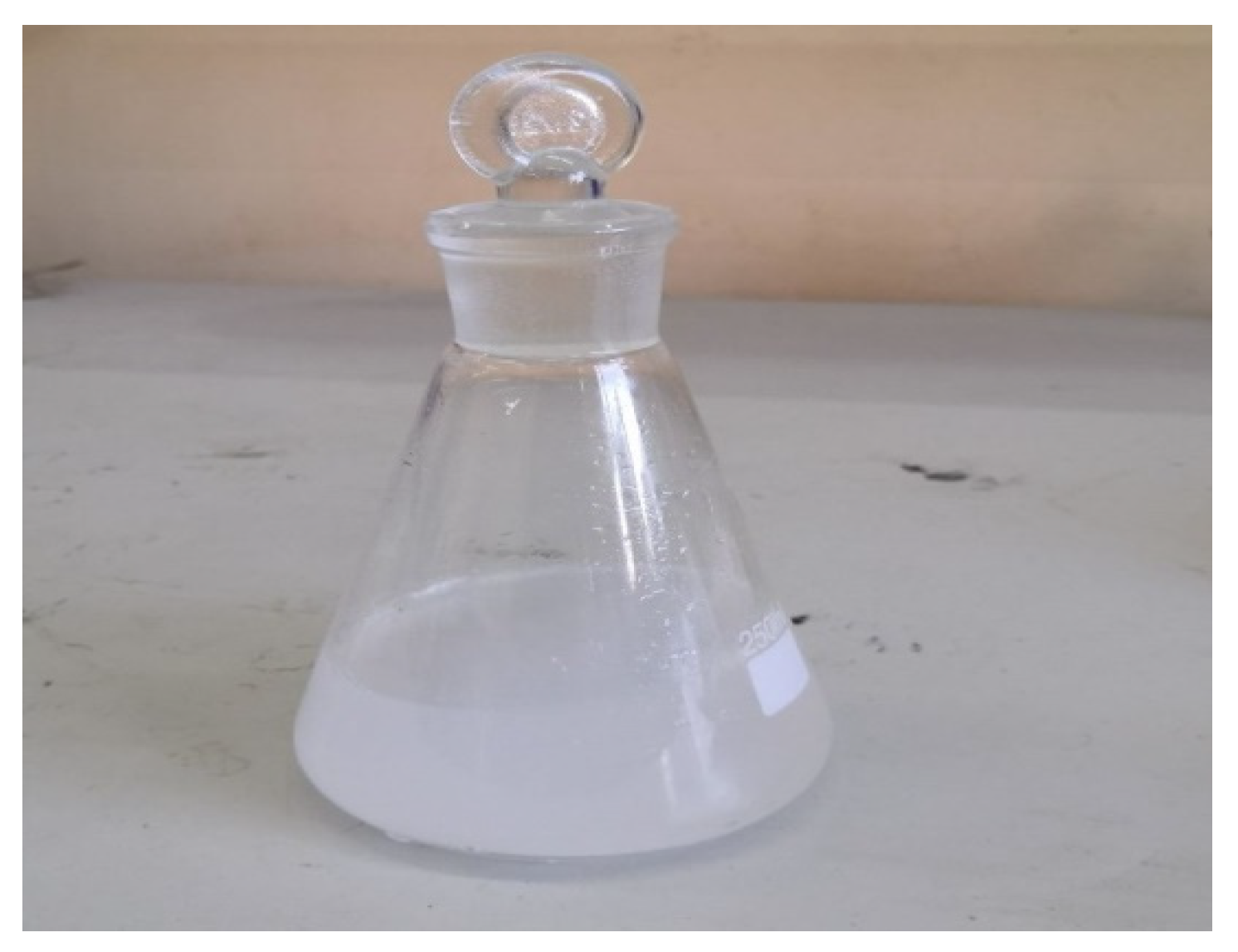

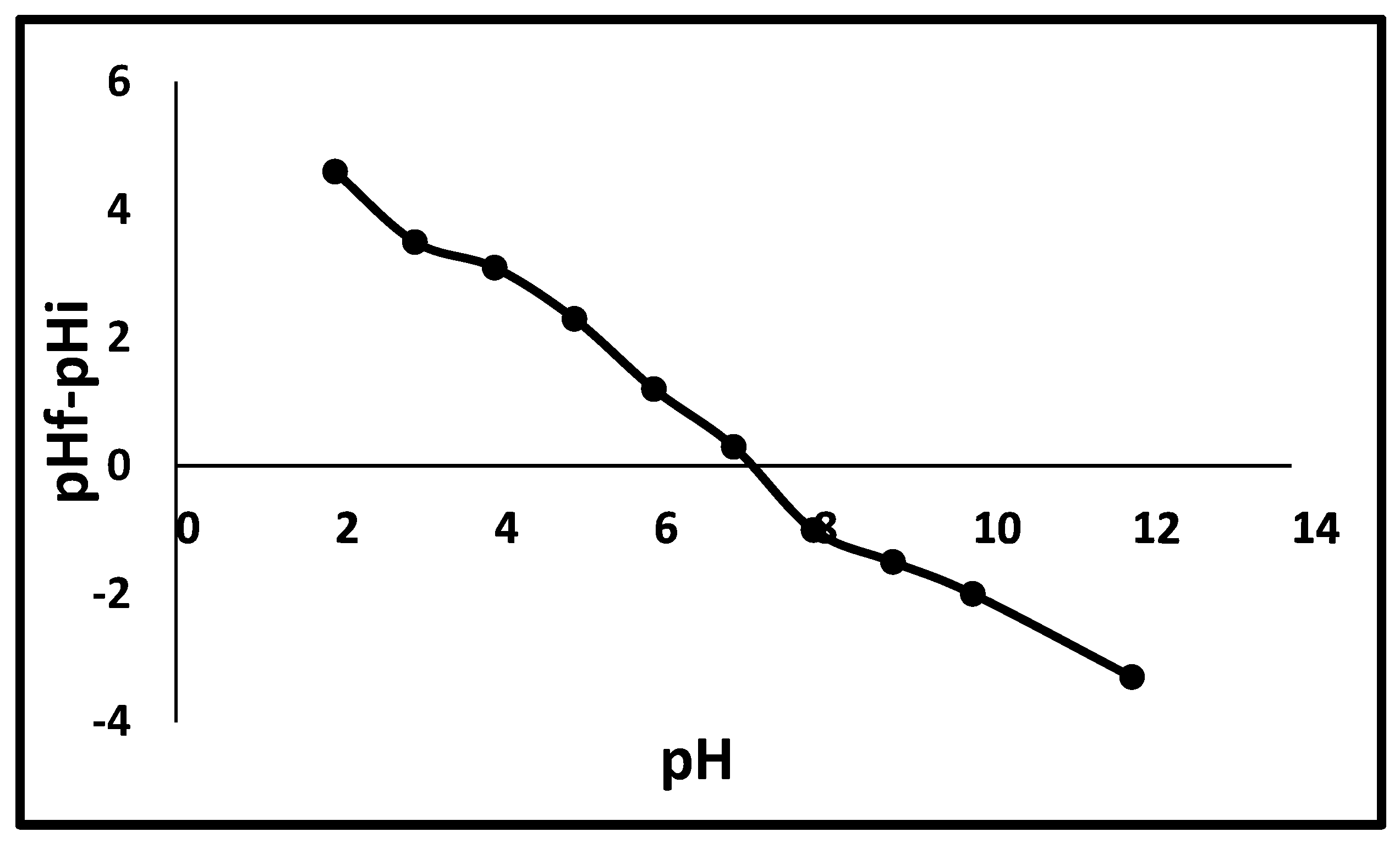


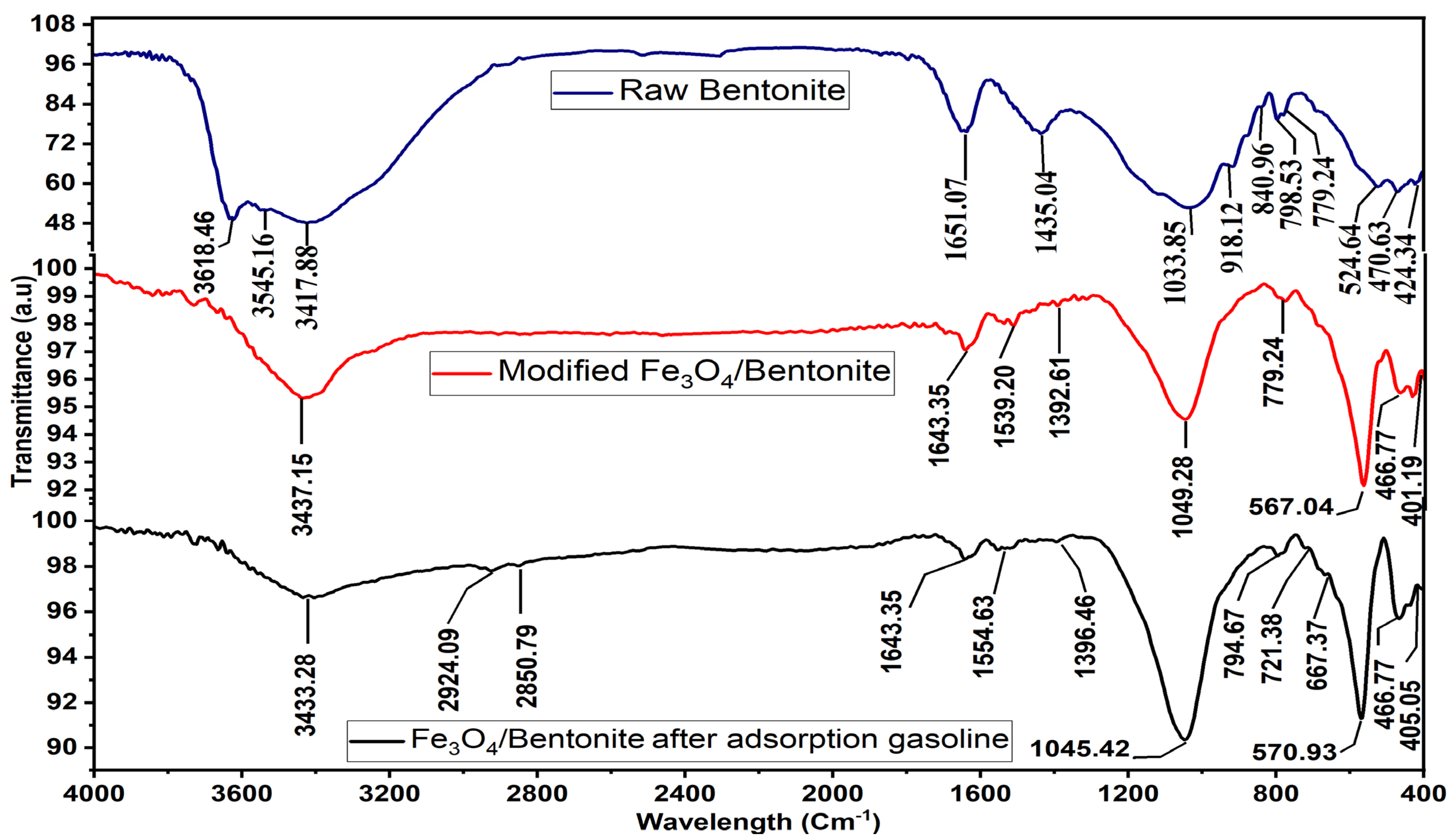
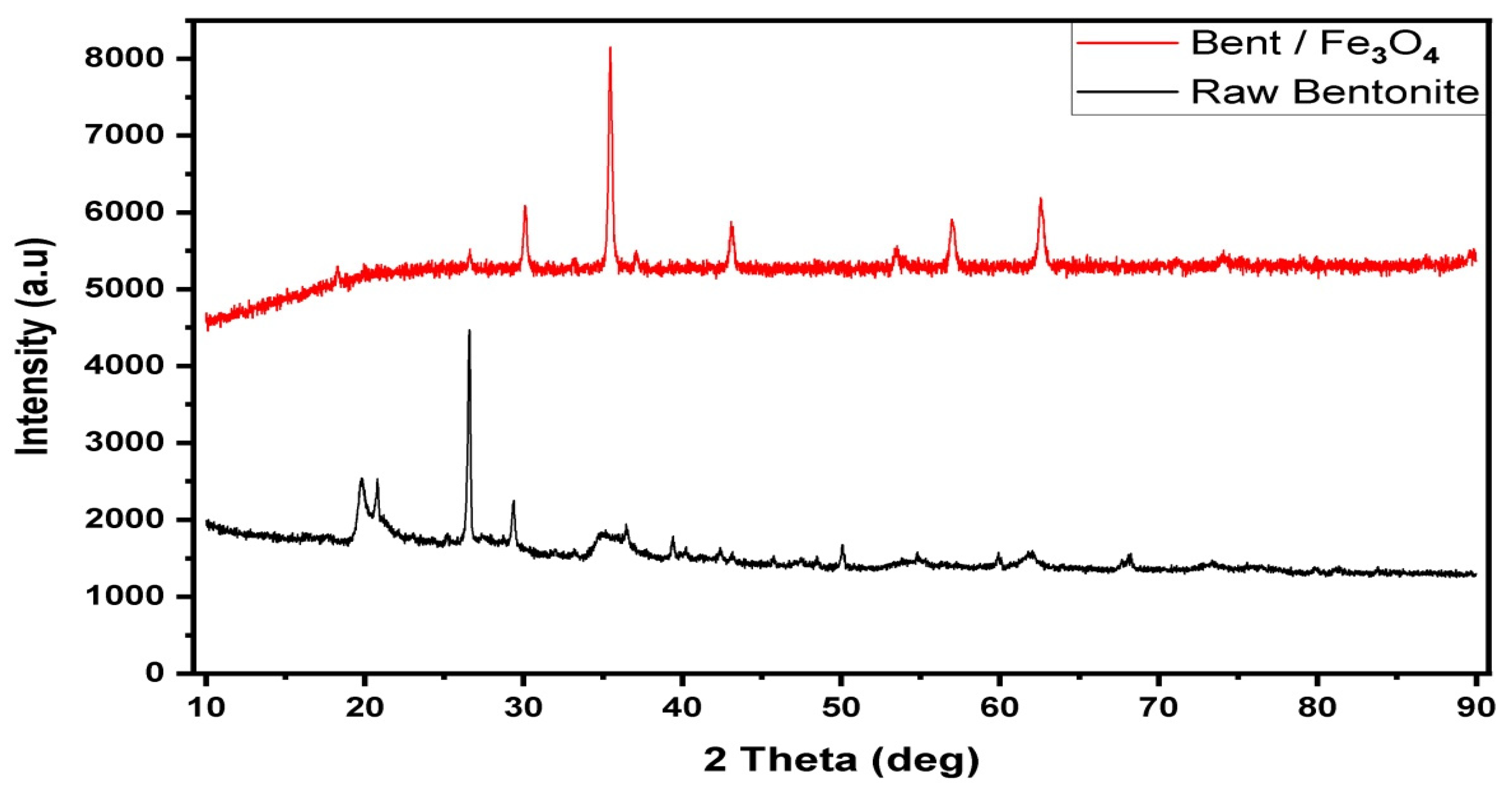
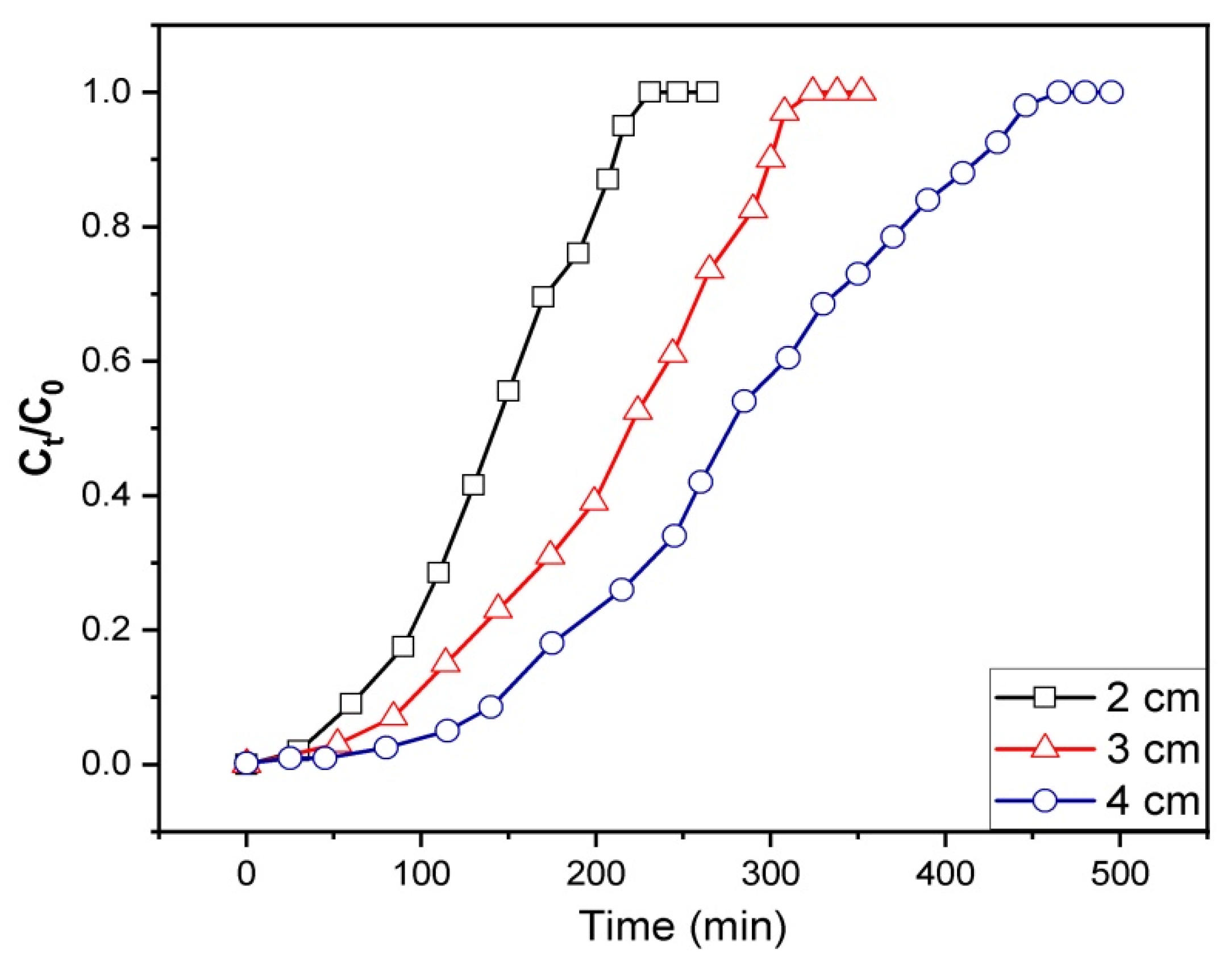
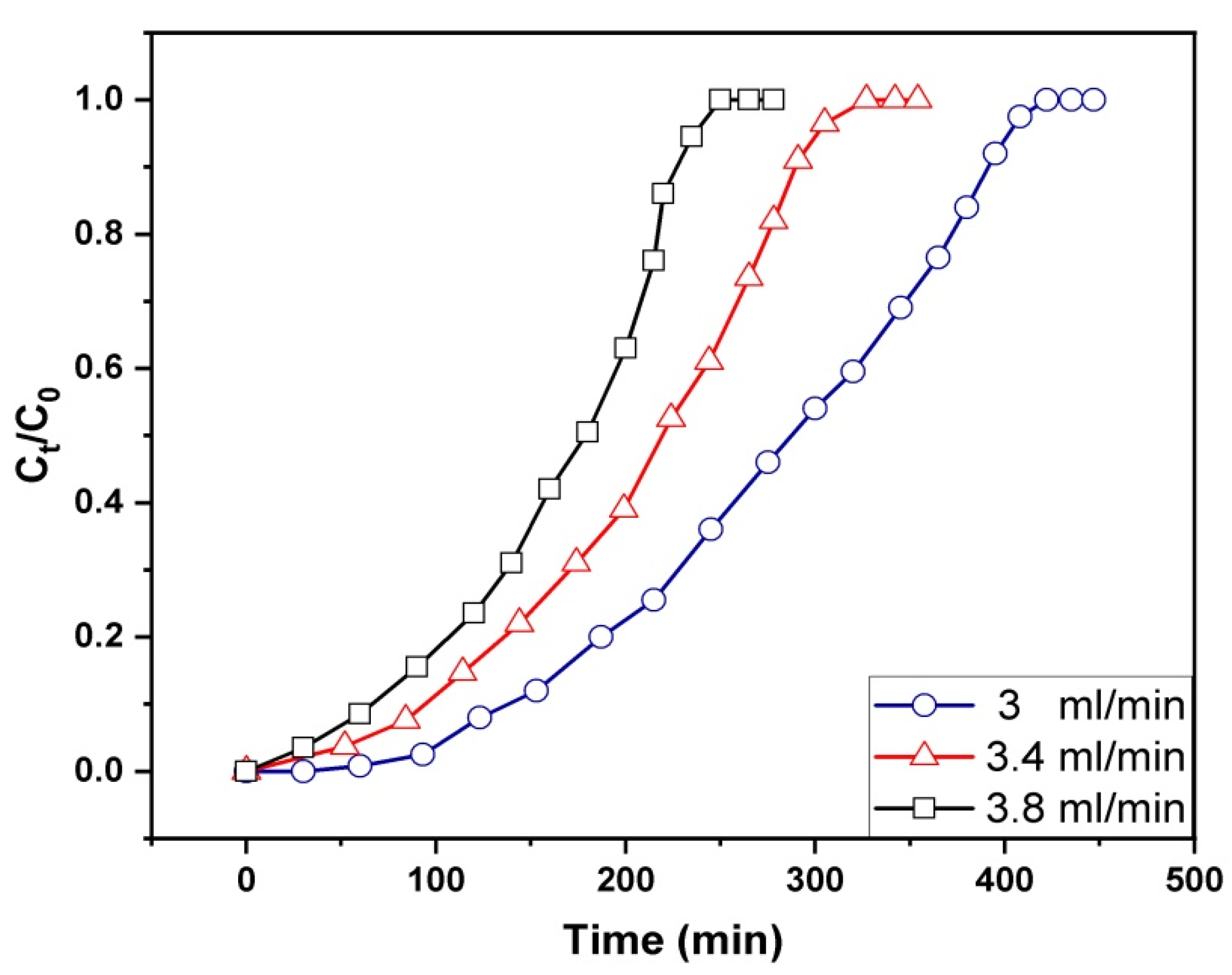


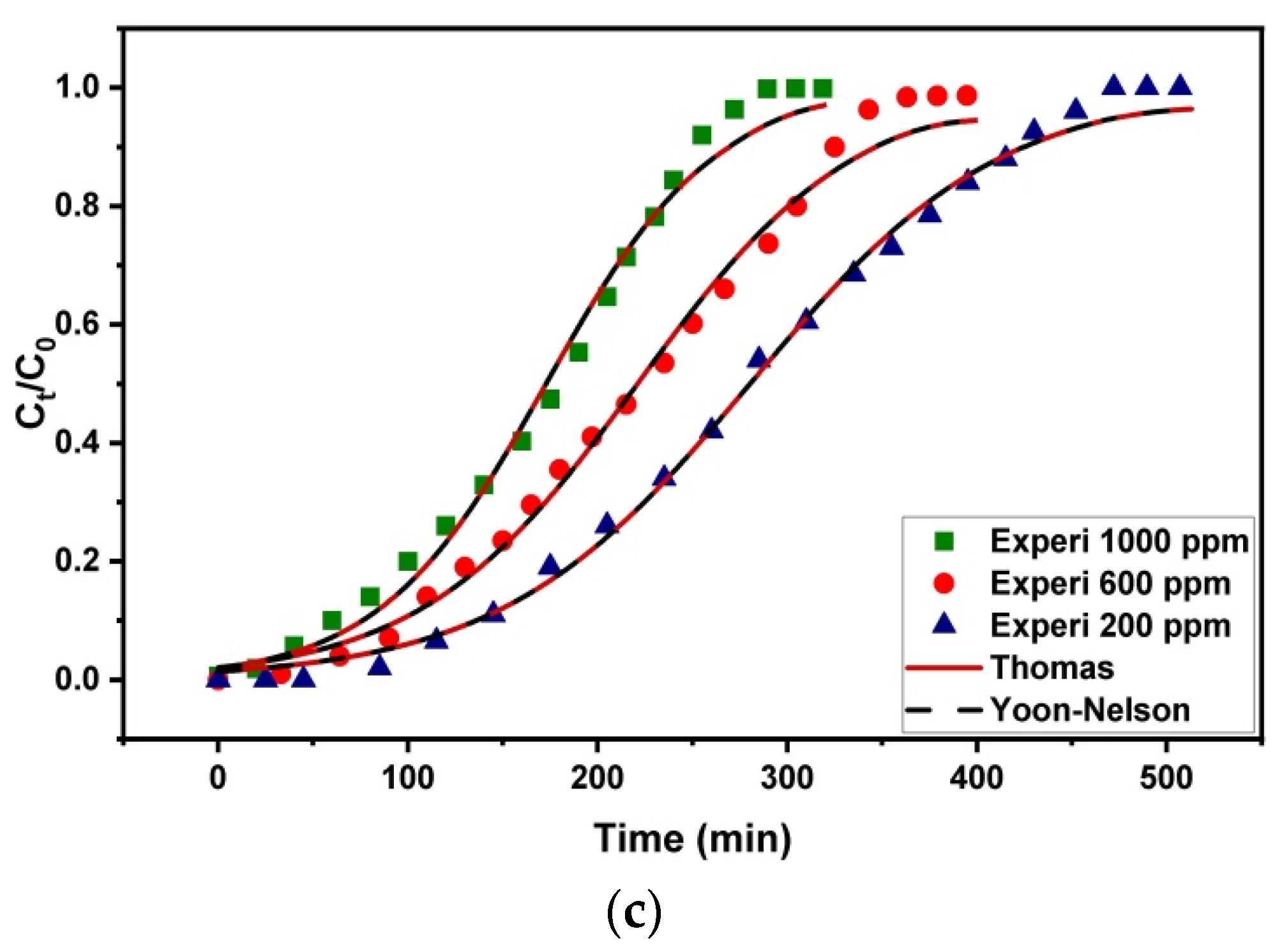
| Raw Bent | Fe3O4/Bent | |
|---|---|---|
| BET surface area (m2/g) | 17.57 | 81.75 |
| Pore volume (cm3/g) | 0.029 | 0.057 |
| Element Weight % | Raw Bentonite | Fe3O4/Bent |
|---|---|---|
| C | 9.1 | 9.0 |
| O | 46.5 | 20.0 |
| Na | 0.8 | - |
| Mg | 2.0 | - |
| Al | 8.3 | 1.0 |
| Si | 17.4 | 4.6 |
| Ca | 3.4 | - |
| Ti | 0.74 | - |
| Fe | 7.1 | 64.5 |
| Parameter | qe (mg/g) | LMTZ | tb | t | |
|---|---|---|---|---|---|
| Flow rate (mL/min) 1 | 3 | 129.14 | 2.28 | 105 | 440 |
| 3.4 | 109.09 | 2.35 | 70 | 325 | |
| 3.8 | 88.10 | 2.40 | 55 | 275 | |
| Bed height (cm) 2 | 2 | 93.71 | 1.68 | 40 | 250 |
| 3 | 109.09 | 2.35 | 70 | 325 | |
| 4 | 121.25 | 3.19 | 95 | 470 | |
| Initial concentration (mg/L) 3 | 200 | 121.25 | 3.19 | 95 | 470 |
| 600 | 218.10 | 3.30 | 60 | 345 | |
| 1000 | 269.46 | 3.61 | 25 | 260 |
| Column Conditions | Thomas Model | Yoon–Nelson Model | |||||||
|---|---|---|---|---|---|---|---|---|---|
| L cm | Q mL/m in | Conc. mg/L | qTH (mg/g) | qe (mg/g) | KTH mL/mg. min | R2 | KYN | τ | R2 |
| 2 | 3.4 | 200 | 91.46 | 93.71 | 0.148 | 0.995 | 0.029 | 142.16 | 0.995 |
| 3 | 3.4 | 200 | 106.21 | 109.09 | 0.103 | 0.985 | 0.0208 | 214.35 | 0.987 |
| 4 | 3.4 | 200 | 122.50 | 121.25 | 0.079 | 0.996 | 0.016 | 279.05 | 0.997 |
| 3 | 3 | 200 | 128.02 | 129.14 | 0.077 | 0.990 | 0.015 | 294.84 | 0.991 |
| 3 | 3.4 | 200 | 106.21 | 109.09 | 0.103 | 0.985 | 0.0208 | 214.35 | 0.987 |
| 3 | 3.8 | 200 | 95.03 | 98.1 | 0.136 | 0.987 | 0.025 | 171.98 | 0.988 |
| 4 | 3.4 | 200 | 122.50 | 121.25 | 0.079 | 0.996 | 0.016 | 279.05 | 0.997 |
| 4 | 3.4 | 600 | 223.11 | 218.1 | 0.029 | 0.988 | 0.0174 | 220.97 | 0.988 |
| 4 | 3.4 | 1000 | 268.72 | 269.46 | 0.022 | 0.986 | 0.022 | 172.75 | 0.986 |
Disclaimer/Publisher’s Note: The statements, opinions and data contained in all publications are solely those of the individual author(s) and contributor(s) and not of MDPI and/or the editor(s). MDPI and/or the editor(s) disclaim responsibility for any injury to people or property resulting from any ideas, methods, instructions or products referred to in the content. |
© 2024 by the authors. Licensee MDPI, Basel, Switzerland. This article is an open access article distributed under the terms and conditions of the Creative Commons Attribution (CC BY) license (https://creativecommons.org/licenses/by/4.0/).
Share and Cite
Sarran, M.A.; AbdulRazak, A.A.; Abid, M.F.; Jawad Al-Bayati, A.D.; Rashid, K.T.; Shehab, M.A.; Mohammed, H.H.; Alsarayefi, S.; Alhafadhi, M.; Alktranee, M. Oily Wastewater Treatment by Using Fe3O4/Bentonite in Fixed-Bed Adsorption Column. ChemEngineering 2024, 8, 92. https://doi.org/10.3390/chemengineering8050092
Sarran MA, AbdulRazak AA, Abid MF, Jawad Al-Bayati AD, Rashid KT, Shehab MA, Mohammed HH, Alsarayefi S, Alhafadhi M, Alktranee M. Oily Wastewater Treatment by Using Fe3O4/Bentonite in Fixed-Bed Adsorption Column. ChemEngineering. 2024; 8(5):92. https://doi.org/10.3390/chemengineering8050092
Chicago/Turabian StyleSarran, Mohammed A., Adnan A. AbdulRazak, Mohammed F. Abid, Alaa Dhari Jawad Al-Bayati, Khalid T. Rashid, Mohammed Ahmed Shehab, Haidar Hasan Mohammed, Saad Alsarayefi, Mahmood Alhafadhi, and Mohammed Alktranee. 2024. "Oily Wastewater Treatment by Using Fe3O4/Bentonite in Fixed-Bed Adsorption Column" ChemEngineering 8, no. 5: 92. https://doi.org/10.3390/chemengineering8050092








